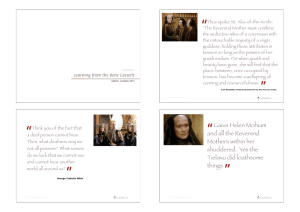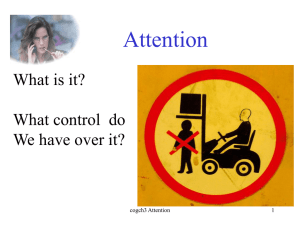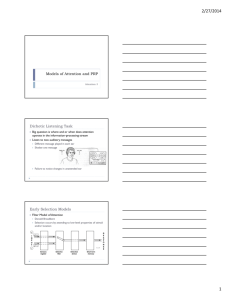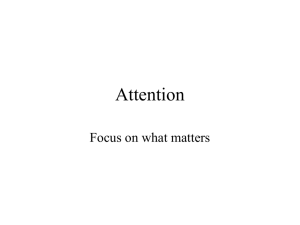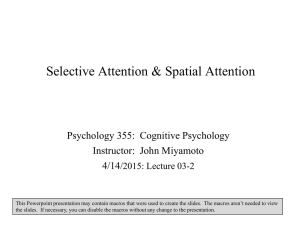cognitive processes
advertisement
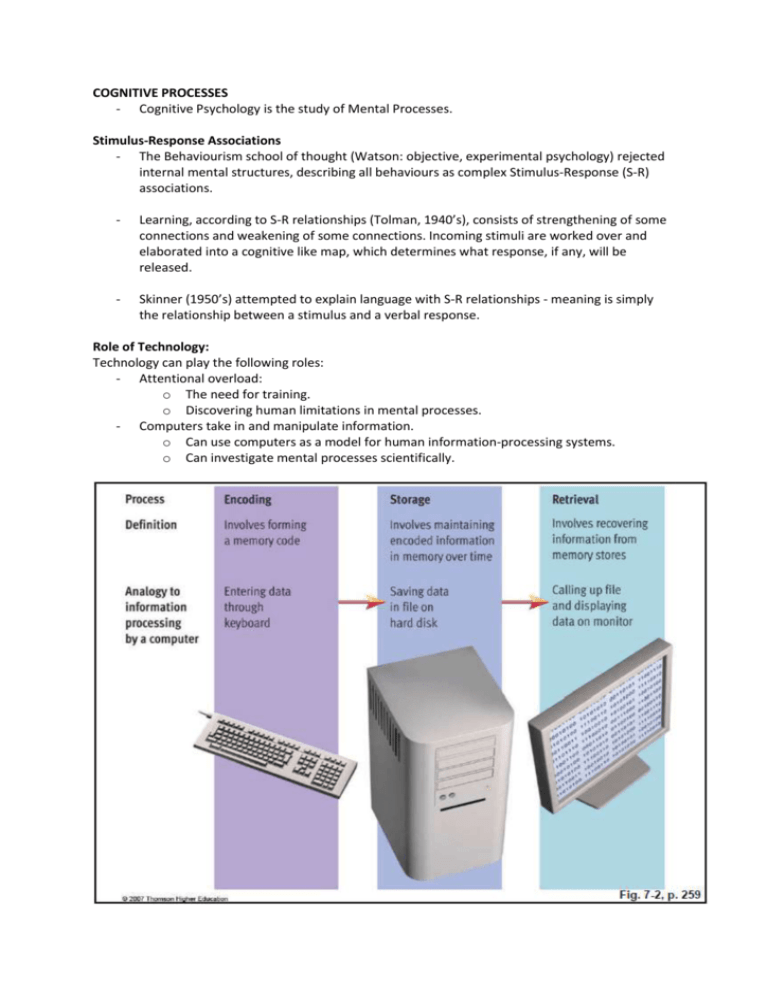
COGNITIVE PROCESSES - Cognitive Psychology is the study of Mental Processes. Stimulus-Response Associations - The Behaviourism school of thought (Watson: objective, experimental psychology) rejected internal mental structures, describing all behaviours as complex Stimulus-Response (S-R) associations. - Learning, according to S-R relationships (Tolman, 1940’s), consists of strengthening of some connections and weakening of some connections. Incoming stimuli are worked over and elaborated into a cognitive like map, which determines what response, if any, will be released. - Skinner (1950’s) attempted to explain language with S-R relationships - meaning is simply the relationship between a stimulus and a verbal response. Role of Technology: Technology can play the following roles: - Attentional overload: o The need for training. o Discovering human limitations in mental processes. - Computers take in and manipulate information. o Can use computers as a model for human information-processing systems. o Can investigate mental processes scientifically. Cognitive models - Memory Registers: - How is sensory input (information received by our senses) kept in our memory: Sensory Memory Working (Short Term) Memory Long Term Memory Key concept in this state Sensory input comes into this sensory register. Involves holding information in an active, readily available state for a short period of time. Information in this register can last for as little as 2 days. How information can be lost Input unattended to is quickly lost in this stage. Unrehearsed information in this register is quickly lost. Some unattended information may be lost overtime. Maintaining information in memory Attended information is transferred into the Working Memory register. Attended information Continuously rehearsed in this register is information is transferred into transferred back into the Long Term Memory register. the Working Memory. Mental Chronometry: - Mental Chronometry is a method of measuring the speed and organisation of mental processes. - It involves comparing an individual’s performance and behaviour of two set tasks which only differ in only one mental process. - An example for measuring speed can be a Simple Vs Choice reaction time task where choice is the added mental process. In this case: o Choice RT – Simple RT = Estimate of stimulus evaluation time. - An example for measuring organisation can be a memory task. In this case, people may: o Parallel: search for all information at the same time. o Serially: search through the information one by one o o Self-terminating: people may stop searching for information once the particular item is found Exhaustive: keep searching through the whole set of information even though they may have found the stimuli already. Cognitive Bias: - Cognitive processes are subject to cognitive biases and reasoning errors that influence our interpretation of events with/without our awareness. - What causes cognitive bias? o Framing: the wording of the problem. o Hindsight Bias: “I knew it all along”. o Conformational Bias: we seek information which confirms our beliefs and ignore information that does not. Attention - Is the cognitive process of selectively concentrating on one aspect of the environment while ignoring other things. Limitation of attention: - We can only pay attention to a limited amount of the information available at any one time (constraint on human informational processing). Why is attention limited? - We can register much information - We can perform high level processing for many inputs at any one time - BUT, we are limited by resources (energy) available for cognitive processing of stimuli. Inattentional Blindness: - Refers to the inability to perceive features or see things which we are not attending to (focussed elsewhere), yet in our sensual range. Selective attention: - How do we select what to attend and pay attention to? - Filters prevent further processing of irrelevant inputs. o Early filter: This filter is used when we attend to a single physical channel or characteristic and reject the rest. o Late filter: This filter is used when we process multiple channels and select/filter on the basis of meaning. The cocktail party effect: o The ability to focus one’s listening attention on a single talker among a mixture of speakers and noise in the background and ignoring other conversations. Dichotic listening: o Occurs when two different auditory stimuli are presented to an individual simultaneously. o Early filter: Occurs when the individual is only aware of crude, distinct information (i.e.: gender, noises) from the unattended ear. o Late filter: Occurs when the individual is aware of the meaning of information in the unattended ear. Control of attention: Change Blindness - Sometimes, even when we are looking for something strange, it takes longer than expected to find it. - When we make a ‘saccade’ or jumping eye movement, the input washes out motion senses. - This can be simulated by inserting ‘blanks’ or flashes in between pictures. Memory: - Memory is stored processes or active processes. Types of memory: - Iconic an Echoic: o Literal copies of visual and auditory events. o Unlimited capacity. o Very short duration Iconic: less than one second. Echoic: between 8-10 seconds. - Short term memory: o Has a capacity of 7±2 units. o Decays within 30 seconds if not rehearsed. o Uses phonological coding - the systematic use of sound to encode information. - Long term memory: o Unlimited capacity. o Memory is forgotten due to interference rather than decay. o Uses semantic coding - the systematic use of meaning to encode information. Central Executive - Responsible for the selection, initiation and termination of processing routines. - Attentional resources are required! - E.g. encoding, storing and retrieving. “Slave” Systems - Phonological loop: o Processes aural information - Visio-spatial scratch pad: o Processes visual and spatial information. Structure of Long Term Memory! Sentence verification tasks - The task of measuring time taken to verify sentences. - If concepts are related, spreading activation from the two concepts will intersect. - Time taken depends on: o Distance between concepts. o Strength of initial activation. o Amount of time since initial activation. o Typical Vs. Less typical questions – takes longer to answer less typical examples. o Category size effect – the bigger the category the quicker the response. E.g. A dog is a mammal > a dog is a animal. Structure of memory – Schema and Scripts - Schema: generalised mental representations of the real world (e.g.: objects). - Scripts: generalised mental representations of events in time (birthday’s and weddings). Priming - When an earlier stimulus influences response to a later stimulus. - For example, when a person reads a list of words including the word table, and is later asked to complete a word starting with tab, the probability that subject answers table is higher than for non-primed people. Explicit and implicit memory tasks - Explicit memory tasks: o E.g. free recall and recognition. o Subjects told to remember items (intentional retrieval). - Implicit tasks: o Not told to remember tasks, only told to perform the task. o Implicit memory is demonstrated when participants are able to identify more old items than new items. o Implicit memory is better preserved over delay. Flashboard memories: - People have very detailed and vivid memory surrounding dramatic world events. - We are more confident about flashboard memory but it decays like any average memory. How to efficiently encode information - Using context. o E.g. mood, time, place, smells and nature of the task. o Transfer appropriate processing principle: Retrieval is best when encoding and retrieval MATCH! - Avoid distractions. - Study at optimal time of the day. - Involve deep processing – ask questions and elaborate on material. - Words which can be better visualised are better remembered – make concrete examples.




